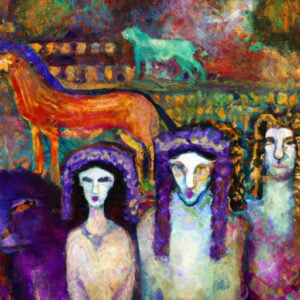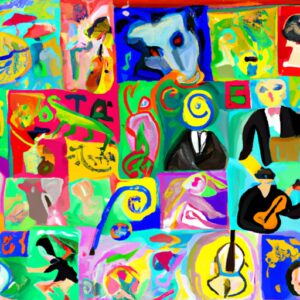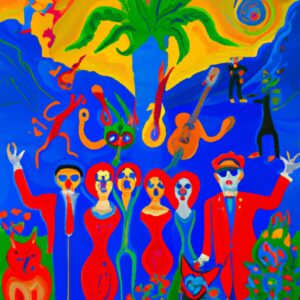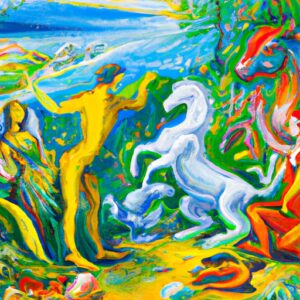Immerse yourself in Italian culture and language! Discover the beauty of Italian through classic songs with lyrics. Buon viaggio into linguistic melodies!
The Rich History of Classic Italian Songs: A Brief Overview
Classic Italian songs hold a rich history that spans centuries and reflects the country’s cultural and artistic heritage. Italy’s musical legacy dates back to ancient times, with evidence of musical instruments and performances in historical texts.
However, it was during the Renaissance period that Italian music flourished and gained recognition across Europe. Composers like Claudio Monteverdi and Giovanni Palestrina made significant contributions to vocal music, paving the way for the development of opera, a genre that would become synonymous with Italian music.
In the 19th and 20th centuries, Italy witnessed the rise of iconic opera composers such as Giuseppe Verdi and Giacomo Puccini, whose works, including “La Traviata” and “Tosca,” continue to be celebrated worldwide.
Alongside opera, traditional Italian folk songs, known as “canzoni popolari,” were also passed down through generations, preserving the country’s diverse regional musical traditions.
Today, classic Italian songs remain an essential part of the nation’s identity. They serve as a reminder of Italy’s artistic prowess and cultural depth, inspiring language learners to delve into the enchanting world of Italian music to better understand the country’s language and culture.
Top Classic Italian Songs
When it comes to classic Italian songs, the choices are vast and varied.
Some of the most beloved and iconic songs have stood the test of time and continue to resonate with audiences around the world.
Songs like “O Sole Mio,” “Volare,” and “Nel Blu Dipinto Di Blu” (commonly known as “Volare”) have become staples in Italian music history.
Here is an old Italian song list that has stood the test of time and continues to be beloved by audiences around the world:
- “O Sole Mio” – A Neapolitan classic written in 1898 by Eduardo Di Capua, with lyrics by Giovanni Capurro. Its catchy melody and passionate lyrics have made it an enduring favorite.
- “Volare” – Also known as “Nel Blu Dipinto Di Blu,” this iconic song was written by Domenico Modugno and Franco Migliacci in 1958. It became an international sensation and earned Italy its first Grammy Award for Song of the Year.
- “Tu Vuò Fà L’Americano” – Written in 1956 by Renato Carosone, Nisa, and Nicola Salerno, this playful song reflects the fascination of Italians with American culture.
- “Con Te Partirò” (Time to Say Goodbye) – A powerful duet performed by Andrea Bocelli and Sarah Brightman, written by Francesco Sartori and Lucio Quarantotto. Its emotional melody has touched hearts worldwide.
- “Caruso” – Composed and performed by Lucio Dalla in 1986, this ballad is a tribute to the legendary Italian tenor Enrico Caruso.
- “Torna a Surriento” – A romantic Neapolitan song was written by Ernesto De Curtis in 1902, capturing the beauty and charm of the Sorrentine Peninsula.
- “La Vie en Rose” (La Vita in Rosa) – Originally a French song by Edith Piaf, the Italian version was popularized by various artists, including Mina and Andrea Bocelli.
- “Quando, Quando, Quando” – Originally performed by Tony Renis and Emilio Pericoli, this lively song has been covered by numerous artists and has become an international hit.
- “Che La Luna” – A classic Italian song popularized by Fred Buscaglione in the 1950s, known for its catchy tune and humorous lyrics.
- “Senza Fine” – Written by Gino Paoli in 1961, this tender ballad has been covered by several artists, including Ornella Vanoni and Dean Martin.
- “Mambo Italiano” – A fun and lively song by Rosemary Clooney, capturing the spirit of Italian-American culture.
- “Guarda Che Luna” – Originally sung by Fred Buscaglione, this song exudes the charm and romance of Italian music from the 1950s.
These old classic Italian songs continue to captivate audiences with their timeless melodies and emotional depth, offering a delightful journey into Italy’s musical heritage.
Learn Italian with Italian Lyrics Translated to English
For Italian language learners, studying Italian lyrics with English translations can be an invaluable tool for comprehension and language development. It allows learners to understand the meaning and emotions conveyed in the songs, enhancing their grasp of Italian vocabulary and expressions.
Reading the translated lyrics alongside the original Italian text helps learners make connections between the two languages and enables them to identify cultural nuances embedded in the songs.
This approach also provides insight into how certain words or phrases are used in different contexts, contributing to a more comprehensive understanding of the Italian language’s grammar and syntax.
Moreover, by studying Italian lyrics translated into English, learners can delve deeper into the themes and stories portrayed in the songs.
Many Italian songs explore love, longing, and nostalgia, offering a unique opportunity to connect with the language on an emotional level. This emotional resonance can make language learning more enjoyable and memorable, as learners associate the language with meaningful experiences and sentiments.
How to Translate Italian Lyrics to English?
Translating Italian lyrics to English is a rewarding but challenging task that requires attention to detail and cultural understanding. To effectively solve Italian songs, one must possess a solid grasp of both languages and be aware of the cultural contexts that shape the song’s meaning.
Begin by listening to the song multiple times to familiarize yourself with the melody and mood. Pay close attention to the words’ pronunciation and try to identify the song’s central theme and the emotions it conveys.
Next, transcribe the original Italian lyrics and look up any unfamiliar vocabulary or idiomatic expressions. Consider the nuances of certain words, as direct translations may not always capture the whole meaning.
Take note of any cultural references that might require explanation in the English translation. When translating, prioritize preserving the essence of the song’s message rather than focusing solely on word-for-word accuracy.
Aim to convey the emotions, metaphors, and imagery present in the original lyrics to create an authentic and evocative translation.
Lastly, seek feedback from native speakers or language experts to refine the translation further. Their insights can help ensure the translated lyrics maintain the intended impact and stay faithful to the spirit of the original Italian composition.
Here is a list of steps to follow when translating Italian lyrics to English:
Familiarize Yourself with the Song: Listen to the Italian song multiple times to get acquainted with the melody, rhythm, and mood. Understand the emotions and themes the music conveys.
Transcribe the Italian Lyrics: Write down the original Italian lyrics in their entirety. Pay attention to word choices, rhymes, and the overall structure of the song.
Look Up Unfamiliar Vocabulary: Identify any unfamiliar words or phrases in the Italian lyrics. Use a reliable dictionary or language resource to find accurate translations and meanings.
Identify Cultural References: Be mindful of cultural references and idiomatic expressions that might not have direct equivalents in English. Consider how to convey their meaning effectively to an English-speaking audience.
Preserve the Song’s Essence: Focus on capturing the essence of the song’s message and emotions rather than translating word-for-word. Aim to maintain the intended impact and sentiment of the original lyrics.
Create Natural and Poetic Translations: Strive for natural-sounding English translations that flow well and maintain the song’s poetic qualities. Consider the rhythm and rhyme scheme to keep the musicality intact.
Seek Feedback: Share your translated lyrics with native speakers or language experts to receive feedback and suggestions for improvement. Incorporate their insights to refine your translation.
Maintain Authenticity: Retain any wordplay, metaphors, or symbolism present in the original lyrics, ensuring the translated version stays true to the artist’s creative vision.
Consider Context and Pronunciation: Think about the context in which the song is sung and ensure that the translated lyrics fit well with the music. Pay attention to pronunciation and how words will be sung in English.
Adapt for Singability: If you plan to sing the translated lyrics, consider adapting them to match the rhythm and melody of the original Italian version. Ensure that the words fit comfortably within the musical framework.
Balance Literal and Figurative Translations: Find a balance between literal translations and figurative expressions. Some phrases may need to be translated more creatively to convey the same emotional impact in English.
Finalize the Translation: After incorporating feedback and making necessary adjustments, finalize the translated lyrics. Make sure they accurately represent the song’s meaning and evoke the intended emotions in English.
Here you can learn Italian with Italian songs for free.
Classic Songwriters and Singers from Italy
Italy’s rich musical history boasts a plethora of iconic songwriters and singers who have left an indelible mark on the world of music. From classical opera composers to legendary crooners, these artists have contributed to Italy’s unparalleled musical legacy, capturing the hearts of audiences across generations.
Giuseppe Verdi (1813-1901): A true giant in the world of opera, Giuseppe Verdi’s masterpieces continue to be celebrated for their emotional depth and dramatic storytelling.
With timeless operas such as “La Traviata,” “Rigoletto,” and “Aida,” Verdi’s contributions to Italian music are beyond measure, leaving a lasting impact on the opera scene worldwide.
Giacomo Puccini (1858-1924): Another revered opera composer, Giacomo Puccini, enchanted audiences with his lush melodies and poignant narratives. His works, including “Madama Butterfly,” “La Bohème,” and “Tosca,” are treasured classics that continue to be performed on opera stages around the globe.
Luciano Pavarotti (1935-2007): One of the most iconic tenors in history, Luciano Pavarotti’s powerful and emotive voice mesmerized listeners worldwide. His interpretations of classical operas and popular songs, alongside fellow tenors Plácido Domingo and José Carreras in the “Three Tenors” concerts, earned him an adoring global fan base.
Enrico Caruso (1873-1921): Regarded as one of the greatest tenors of all time, Enrico Caruso’s recordings remain cherished relics of Italian vocal artistry. His performances in operas like “La Bohème” and “Rigoletto” set the standard for operatic excellence during the early 20th century.
Umberto Bindi (1932-2002): Known for his exceptional songwriting talents, Umberto Bindi penned heartfelt and soul-stirring ballads that struck a chord with Italian audiences. His timeless song “Il Nostro Concerto” became a national sensation, cementing his place as a revered songwriter.
Exploring the works of these legendary songwriters and singers from Italy’s past not only allows language learners to appreciate their musical brilliance but also offers a unique opportunity to deepen their understanding of the Italian language and its emotive power.
These artists’ contributions to Italy’s musical heritage continue to resonate and inspire audiences worldwide.
Learn Italian with Italian Music
In conclusion, learning Italian with Italian music is an immersive and enjoyable way to deepen your language skills and connect with the rich cultural heritage of Italy. From classic opera masterpieces to contemporary pop hits, the vast repertoire of Italian music offers something for every language learner.
One aspect that should not be overlooked is the importance of listening to slow Italian songs. These melodic tunes not only allow learners to savor the beauty of the Italian language but also provide a unique opportunity to grasp pronunciation, intonation, and subtle nuances.
The slower tempo allows learners to follow the lyrics more closely, enhancing their comprehension and language retention.
Moreover, slow Italian songs often delve into profound emotions and storytelling, providing learners with a window into the cultural aspects and artistic expressions of Italy.
Through such songs, learners can explore themes like love, nostalgia, and passion, gaining a deeper understanding of Italian sentiments and cultural values.
As you embark on your journey to learn Italian, don’t forget to include slow Italian songs in your playlist. Immerse yourself in the enchanting melodies and captivating lyrics, and witness how these musical experiences enrich your language learning process.
With the power of music, let Italian become not just a language but an emotional and cultural journey that connects you with the heart and soul of Italy.
Make sure you understand everything with Slow Italian Songs.










2 Responses
Giovanni Trozzo: Thank you so much for your kind words! I appreciate your agreement and support. Let’s continue to make this online community a positive and friendly place. Keep shining your kindness!
Great job on your comment! I completely agree with your point. It’s always nice to see positive and friendly comments on posts. Keep spreading the kindness!